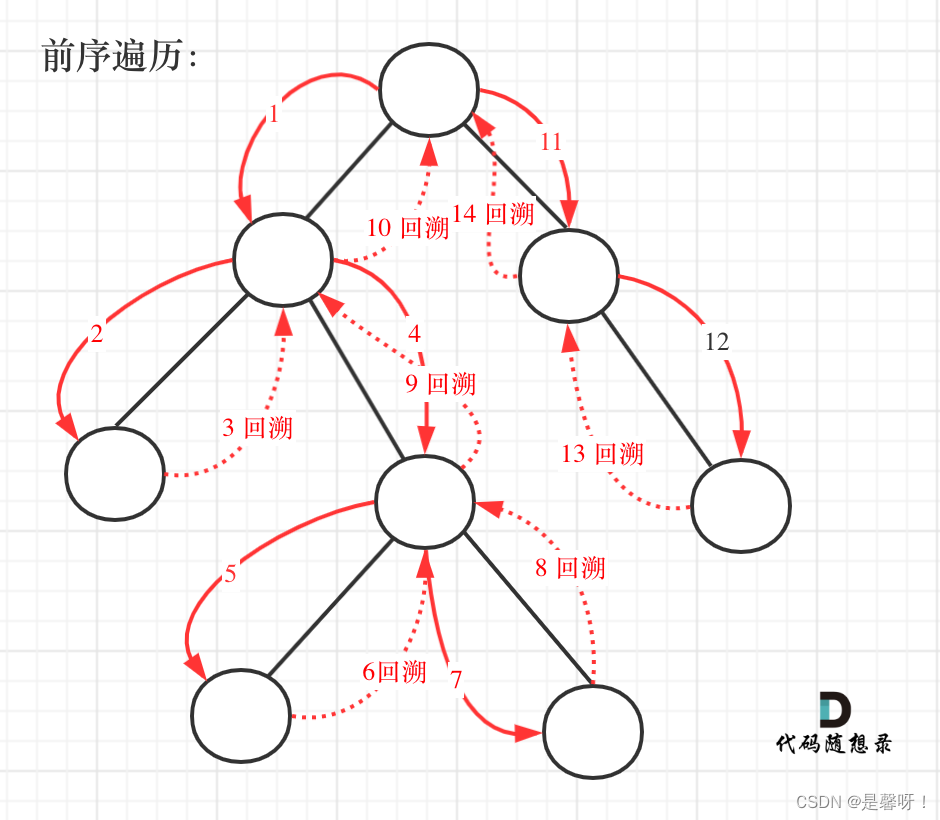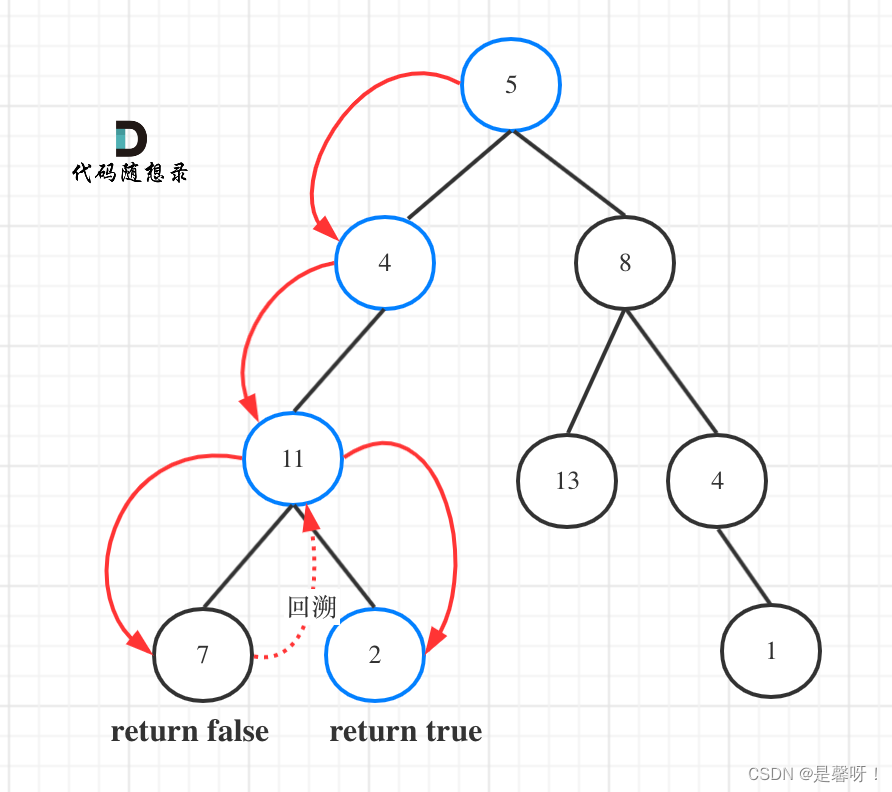-
二叉树路径问题+递归+有关题目
一、分类
1、自顶向下
顾名思义,就是从某一个节点(不一定是根节点),
从上向下寻找路径,到某一个节点(不一定是叶节点)结束,具体题目如下:而继续细分的话还可以分成一般路径与给定和的路径- 二叉树的所有路径
- 面试题 04.12. 求和路径
-
- 路径总和
-
- 路径总和 II
- 437 路径总和 III
- 988 从叶结点开始的最小字符串
2、非自顶向下:
就是
从任意节点到任意节点的路径,不需要自顶向下
124. 二叉树中的最大路径和
125. 最长同值路径
126. 二叉树的直径二、关于递归
- 回溯和递归式一一对应的。回溯的目的是path 不能一直加入节点,它还要删节点,然后才能加入新的节点。
- 递归函数的返回值问题
- 如果需要搜索整棵二叉树且不用处理递归返回值,递归函数就不要返回值。(113.路径总和ii)
- 如果需要搜索整棵二叉树且需要处理递归返回值,递归函数就需要返回值。 (236. 二叉树的最近公共祖先 )
- 如果要搜索其中一条符合条件的路径,那么递归一定需要返回值,因为遇到符合条件的路径了就要及时返回。(112.路径总和)
三、解题模板
这类题通常用深度优先搜索(DFS)和广度优先搜索(BFS)解决。所以掌握二叉树的遍历思想很重要。
1、自顶而下
一般路径
// 定义一个数组,用于存储遍历二叉树时走过的所有路径 let res = [] // 遍历二叉树,一般而言,就是使用DFS或者是BFS // 遍历的时候,每进入一个分支,需要将当前节点的值放入path中,path代表是每条路径。 // 当一个分支结束也就是单层递归结束的时候,将path放入最后的res var dfs = function(root,path){ if(!root) return // 节点为空,直接返回 // 处理根节点 path.push(root.val) //单个分支结束递归条件,节点root为叶子节点 if(!root.left && !root.right){ res.push(path) return } // 节点root为非叶节点,检查左右节点继续遍历 // 此时会一直向左走,即先遍历完左子树 if(root.left){ dfs(root.left,path) path.pop() // 回溯 } // 左子树结束,此时还在倒数第二节点的递归内,所以此时是回溯了 if(root.right){ dfs(root.right,path) path.pop() // 回溯 } } dfs(root,[]) // 返回最后的结果数组,即所有的路径 return res- 1
- 2
- 3
- 4
- 5
- 6
- 7
- 8
- 9
- 10
- 11
- 12
- 13
- 14
- 15
- 16
- 17
- 18
- 19
- 20
- 21
- 22
- 23
- 24
- 25
- 26
- 27
- 28
- 29
- 30
- 31
- 32
给定和的路径
// 定义一个数组,用于存储遍历二叉树时满足条件的路径 let res = [] // 遍历二叉树,一般而言,就是使用DFS或者是BFS // 遍历的时候,每进入一个分支,需要将当前节点的值放入path中,path代表是每条路径。并且需要将目标值sum-节点当前值。 // 当一个分支结束也就是单层递归结束的时候,检查sum是否为0 var dfs = function(root,sum,path){ if(!root) return // 节点为空,直接返回 // 每遍历到一个节点的逻辑 path.push(root.val) // 做出选择 sum -= root.val //单个分支结束递归条件:节点root为叶子节点 // 检查到满足条件的路径:sum此时为0 if(!root.left && !root.right && sum == 0){ res.push(path) return } // 节点root为非叶节点,继续遍历左右子树 if(root.left){ dfs(root.left,sum,path) path.pop() // 回溯 } if(root.right){ dfs(root.right,sum,path) path.pop() // 回溯 } } dfs(root,sum,path) // 返回最后的结果数组 return res- 1
- 2
- 3
- 4
- 5
- 6
- 7
- 8
- 9
- 10
- 11
- 12
- 13
- 14
- 15
- 16
- 17
- 18
- 19
- 20
- 21
- 22
- 23
- 24
- 25
- 26
- 27
- 28
- 29
- 30
- 31
- 32
- 33
2、非自顶而下
思想:设计一个辅助函数maxpath,调用自身求出以一个节点为根节点的左侧最长路径left和右侧最长路径right,那么经过该节点的最长路径就是left+right。每次不断更新全局变量即可。
注意:- left,right代表的含义要根据题目所求设置,比如最长路径、最大路径和等等
let res=0; // 递归函数需要返回值 var maxPath = function(root) //以root为路径起始点的最长路径 { // 单层递归结束条件 if (!root) return 0; // 单层逻辑 int left=maxPath(root.left); int right=maxPath(root.right); res = max(res, left + right + root.val); //更新全局变量 // 单层递归逻辑的返回值 return max(left, right); //返回左右路径较长者 } maxPath(root) return res- 1
- 2
- 3
- 4
- 5
- 6
- 7
- 8
- 9
- 10
- 11
- 12
- 13
- 14
- 15
- 16
三、题目
257. 二叉树的所有路径

使用模板1。递归函数不需要返回值。
var binaryTreePaths = function(root) { // res是最后的结果数组,不参与遍历 let res = [] // 1. 确定递归函数 函数参数。这里的递归函数不需要返回值。 var dfs = function (root,path){ if(!root) return path += String(root.val) // 2. 确定终止条件,叶子节点,将单分支路径path放入res,并且结束单分支路径 if(!root.left && !root.right){ res.push(path) return // 单层递归结束 } // 3. 确定单层递归逻辑,非叶节点 if(root.left){ dfs(root.left,path+ '->') } if(root.right){ dfs(root.right,path+ '->') } } dfs(root,"") return res };- 1
- 2
- 3
- 4
- 5
- 6
- 7
- 8
- 9
- 10
- 11
- 12
- 13
- 14
- 15
- 16
- 17
- 18
- 19
- 20
- 21
- 22
- 23
- 24
- 25
- 26
- 27
其实这个题目是运行了回溯的,回溯就隐藏在 dfs(root.right,path+ ‘->’);中的 path + “->”。上面的代码实际上是下面的代码。
当最左边的分支结束,即叶子节点7递归结束。回到了11节点的递归中,此时检查11的右节点是否存在。if (cur->left) { path += "->"; traversal(cur->left, path, result); // 左 path.pop_back(); // 回溯 '>' path.pop_back(); // 回溯 '-' } if (cur->right) { path += "->"; traversal(cur->right, path, result); // 右 path.pop_back(); // 回溯 '>' path.pop_back(); // 回溯 '-' }- 1
- 2
- 3
- 4
- 5
- 6
- 7
- 8
- 9
- 10
- 11
- 12
129. 求根节点到叶节点数字之和
使用模板1。递归函数不需要返回值。
这道题实际上是用不到回溯的,你把tmp = (tmp-root.val)/10; 这一行删了也对。原因是函数内部执行完返回之后tmp仍然是原来的值不会因为函数的执行而改变,这是Java值传递的效果,只传了个副本进去。前面有些dfs函数内部传了String,List这些引用类型的才需要回溯var sumNumbers = function(root) { // 所有的路径res, let res = 0,path = 0 var dfs = function(root,path){ // 计算单个分支的和,可以使用字符相加 path = path * 10 + root.val // 单层递归结束 if(!root.left && !root.right){ // 把字符串path转换为数字进行累加 res = res + path return } // 检查左右节点 if(root.left) { dfs(root.left,path) } if(root.right) { dfs(root.right,path) } path = (path - root.val) / 10 // 回溯,可要可不要 } if(!root) return 0 dfs(root,path) return res };- 1
- 2
- 3
- 4
- 5
- 6
- 7
- 8
- 9
- 10
- 11
- 12
- 13
- 14
- 15
- 16
- 17
- 18
- 19
- 20
- 21
- 22
- 23
- 24
- 25
- 26
- 27
- 28
- 29
112. 路径总和
使用
模板2,这个题目不是返回路径,而是判断是否存在。注意这个递归函数是需要返回值的,即遇到合适的路径立刻返回,不需要遍历整棵树。

var hasPathSum = function(root, targetSum) { // 1、不需要返回值 var dfs = function(root,reSum){ // 2、终止条件 // 叶子节点,且和为sum if(!root.left && !root.right && reSum== 0){ return true } // 叶子节点,和不为sum if(!root.left && !root.right && reSum!= 0){ return false } // 3、单层递归逻辑,需要返回值 // 遇到叶子节点返回true,则直接返回true if(root.left && hasPathSum(root.left,reSum-root.left.val)){ return true } if(root.right && hasPathSum(root.right,reSum-root.right.val)){ return true } // 其他情况就是fasle return false } if(!root) return false // 需要返回值 return dfs(root,targetSum-root.val) };- 1
- 2
- 3
- 4
- 5
- 6
- 7
- 8
- 9
- 10
- 11
- 12
- 13
- 14
- 15
- 16
- 17
- 18
- 19
- 20
- 21
- 22
- 23
- 24
- 25
- 26
- 27
- 28
- 29
以上代码中是包含着回溯的,没有回溯,如何后撤重新找另一条路径呢。
回溯隐藏在(root.right,reSum-root.right.val)这里, 因为把reSum-root.right.val直接作为参数传进去,函数结束,reSum的数值没有改变。
if (cur->left) { // 左 count -= cur->left->val; // 递归,处理节点; if (traversal(cur->left, count)) return true; count += cur->left->val; // 回溯,撤销处理结果 } if (cur->right) { // 右 count -= cur->right->val; if (traversal(cur->right, count)) return true; count += cur->right->val; } return false;- 1
- 2
- 3
- 4
- 5
- 6
- 7
- 8
- 9
- 10
- 11
113. 路径总和 II
使用模板2var pathSum = function(root, targetSum) { let res = [],path = []; // 1、递归函数,不需要返回值 var dfs = function(root,reSum,path){ // 2、分支递归结束条件 叶子节点 if(!root.left && !root.right && reSum== 0){ // 深拷贝 res.push([...path]) return // 结束单分支 } if(!root.left && !root.right && reSum!= 0) return; // 非叶 if(root.left){ // 存值 path.push(root.left.val) dfs(root.left,reSum-root.left.val,path) // 这里也有回溯的思想,参考上一题 // 一直向左之后,需要回溯,进入下一个分支 path.pop() // 回溯,将存入的值弹出 } if(root.right){ path.push(root.right.val) dfs(root.right,reSum-root.right.val,path) path.pop() } // 其他 return; } if(!root) return res; // 把根节点提前放入路径 dfs(root,targetSum-root.val,[root.val]) return res };- 1
- 2
- 3
- 4
- 5
- 6
- 7
- 8
- 9
- 10
- 11
- 12
- 13
- 14
- 15
- 16
- 17
- 18
- 19
- 20
- 21
- 22
- 23
- 24
- 25
- 26
- 27
- 28
- 29
- 30
- 31
- 32
- 33
- 34
实际上的两处回溯:
if (cur->left) { // 左 (空节点不遍历) path.push_back(cur->left->val); count -= cur->left->val; traversal(cur->left, count); // 递归 count += cur->left->val; // 回溯 path.pop_back(); // 回溯 } if (cur->right) { // 右 (空节点不遍历) path.push_back(cur->right->val); count -= cur->right->val; traversal(cur->right, count); // 递归 count += cur->right->val; // 回溯 path.pop_back(); // 回溯 }- 1
- 2
- 3
- 4
- 5
- 6
- 7
- 8
- 9
- 10
- 11
- 12
- 13
- 14
- 15
543. 二叉树的直径
使用
模板3,求出的是路径的长度最大值
整个二叉树路径最长 = 左子树最长+右子树最长,所以使用递归的思想。var diameterOfBinaryTree = function(root) { // res统计路径 let res = 0 // 整个二叉树路径最长 = 左子树最长+右子树最长 var maxDepth = function(root){ // 递归结束条件 if(!root) return 0 // 单层递归逻辑 // 左最长 let left = maxDepth(root.left) // 右最长 let right = maxDepth(root.right) // 更新全局变量res res = Math.max(left+right,res) // 返回值 return Math.max(left,right)+1 } maxDepth(root) return res };- 1
- 2
- 3
- 4
- 5
- 6
- 7
- 8
- 9
- 10
- 11
- 12
- 13
- 14
- 15
- 16
- 17
- 18
- 19
- 20
- 21
- 22
- 23
124. 二叉树中的最大路径和
使用
模板3,求出的是路径上节点的和的最大值.var maxPathSum = function(root) { // 最大路径和,res为负无穷,因为节点值可能为负数 // 全局变量res的初值设置是0还是-Infinity要看题目节点是否存在负值,如果存在就用-Infinity,否则就是0 let res = -Infinity // 递归函数 var dfs = function(root){ // 单层递归结束条件 if(!root) return 0 // 左右子树的和最大值,节点值可能为负数 let left = Math.max(dfs(root.left),0) let right = Math.max(dfs(root.right),0) // 更新res res = Math.max(left+right+root.val,res) // 单层逻辑返回值 return Math.max(left,right)+root.val } dfs(root) return res };- 1
- 2
- 3
- 4
- 5
- 6
- 7
- 8
- 9
- 10
- 11
- 12
- 13
- 14
- 15
- 16
- 17
- 18
- 19
- 20
- 21
- 22
- 23
- 24
-
相关阅读:
java实现贪心算法代码示例
统计和为 K 的子数组个数
gdb工具使用方法和常用指令介绍
【笔记】判断高电平,低电平和方波的几种方法
springcloud+vue+elementUI springcloud分布式架构网上购物商城-#毕业设计
机器视觉康耐视visionpro-脚本常见的编辑编译错误和运行错误及警告性错误,调试解决办法
双软企业两免三减半政策
设计模式面试系列-03
GateWay实现负载均衡
操作系统——网络编程——socket——TCP/UDP
- 原文地址:https://blog.csdn.net/weixin_43466639/article/details/127998828
